Film, Radio and TV - 2 |
|
The Early Days
If nothing else, the fear that motion pictures would ruin the country's morals spoke to the power and influence of film. Of course, film wasn't the only villain; later it was claimed that such things as rock-and-roll music, miniskirts and two-piece bathing suits would also ruin the country's morals.
By 1910, Nickelodeon theaters were attracting 26-million viewers each week. Just five years later, that number had more than doubled. The popularity of films soon attracted the attention of big companies that saw the potential for big profits. And, what better way to insure big profits than to try to create a monopoly in an attempt to control everything. Led by Thomas Edison, several companies formed a trust called the Motion Picture Patents Company (MPPC). The plan was to use their combined patents to control things such as the production of raw film stock, projection equipment, and film distribution and exhibition; in other words, almost everything in the motion picture industry. Independent (nonaffiliated) film companies tried to compete at their own risk. MPPC people raided the independent studios that attempted to make films; equipment was smashed and employees were threatened. Their strong-arm tactics aside, the MPPC did establish standards and create an internationally competitive motion picture industry.
It was assumed that if audiences became familiar with leading characters that the actors would achieve a star status and demand more than the minimal wages they were earning. As we will see, this was pretty shortsighted thinking.
|
|
D. W. Griffith In 1915, one of the most noteworthy films in the history of motion pictures was released: Birth of a Nation. The three-hour film was made to commemorate the 50th anniversary of the
ending of the Civil War in the United States. It cost less than $110,000 to make
and earned more than $18 million. It also made pioneer film maker D. W. Griffith famous for introducing sophisticated film and storytelling techniques. (Griffith had started out trying to be an actor, and when that didn't work out he decided to try his hand at directing.) Interestingly, the entire film was shot without a script. The film chronicled a part of U.S. history from pre-Civil War days through the Reconstruction. It was accompanied by a complete musical score performed live in theaters by symphony orchestras. Even though Birth of a Nation represented a quantum leap in film techniques, because of its racist theme it was highly controversial. The film was said to have, "a flawed, sentimental attachment to the Old South." (Griffith was from the South.) Among other things, violent, anti-Negro Ku Klux Klan members emerged as heroes. The showing of the film resulted in race riots in major cities and inspired the rebirth of the Ku Klux Klan in the South. If there was any doubt about the influence of this new medium, the issue was settled with Birth of a Nation. Even today, some colleges that have tried to screen the film for historic reasons have met with major opposition. Griffith's second film, Intolerance,
in 1916, had a Not only was it ahead of its time in terms of technique, but also people didn't want to hear a message about tolerance--especially when the United States was preparing to go to war. As a result, Griffith, who in part wanted to address criticism for Birth
of a Nation (and who had invested his own money in Intolerance), was
almost wiped out financially. (Excerpts from some of D.W. Griffith's films can be
As we've noted, films were originally shot on the East coast of the United States where the film business originated. This soon changed, primarily for two reasons. First, many films were shot outside--a lot of light was needed to accommodate the slow speed of the film in those days--and the weather on the East Coast often didn't cooperate. But, "it never rains in Southern California" (at least according to the song), and "out West" there was sunshine and wide open spaces available for making films--not to mention a very big ocean and lots of picturesque mountains. Independent film companies fighting the stranglehold of the East Coast MPPA trust, moved to the West Coast. On the West Coast they were much farther away from MPPA control. (And it should be noted, close to Mexico, in case they had to quickly close up operations and make a hasty retreat to a safer terrain!) Once the independent film companies were established in California, they started turning out films that were as good as, and often better than, the ones being produced by MPAA companies. But, even more bad news for the MPPC trust was on the horizon. In 1915, the U.S. government finally acted to break up the trust under antimonopoly laws. (But, lest anyone feel sorry for these companies, within a few years the East Coast film moguls would soon be back with an even bigger monopoly.) Before we get to that, we need to mention how "Hollywood" came into being. For those not familiar with the Los Angeles, California area, Hollywood (which eventually became known as "the film capital of the world") is geographically a part of Los Angeles. Interestingly, the name "Hollywood" rests on an illusion, just as "motion" pictures do. A real estate agent who had moved to the Los Angeles area from the East
Coast had brought with him a lot of holly trees. Not being troubled with such
things as botany and geographic differences, he optimistically planted them, thinking
that he would introduce a new species of trees to the They all died. Not to be deterred (real estate people tend to be an optimistic lot), he still named the area "Hollywoodland," and put up a large sign on the side of a mountain to advertise the area. Later the name was shortened to "Hollywood," as shown here. Holly trees or no holly trees, the area ended up being an ideal site for
early motion picture studios. The Star System Is Born
The independent studios that had set up shop on the West Coast saw things differently. They immediately recognized an advantage in developing popular stars that audiences would pay to see time and time again. The fact that this approach would draw audiences away from rival MPPC films didn't escape their notice either. One of the first actors to be promoted in this way was Florence Lawrence--yes, Florence Lawrence! She is credited with being the first movie star. (A nice trivia question!) Two stars from this early era whose names
are definitely famous in the annals of film history are Mary Pickford (known at
the time as "America's Sweetheart") and Charlie Chaplin, If you walk along the "Walk of Fame" on Hollywood Boulevard between La Brea and Vine Streets in Hollywood, you will see their names embedded in the sidewalk along with bronze stars. They are just two of scores of film, radio and TV notables spanning almost a century of history who are commemorated in this way. Here are some more.
Do the names Hal Roach, Mack Sennett, and
Laurel and Hardy ring a bell? They are also noted on the Hollywood Walk of
Fame, and they were the comedy teams of the Their physical humor didn't need dialogue, so the tens of thousands of U.S. immigrants of the period, along with people around the world, regardless of language, could appreciate their antics. The first 20th Century superstar was Charlie Chaplin, the undisputed comic genius of silent comedy. He started out working at $150 a week, and by 1917 was making more than a million a year.
There was more than just empty-headed humor in his work; Chaplin used his films to subtly communicate messages about good and evil in society--and especially the disparity between the haves and have-nots. Although Chaplin's work was immensely popular, some of the "haves" didn't appreciate his pointing out the social problems resulting from the financial inequities of the early 1900s. It didn't help that Chaplin led a bit of a freewheeling, lascivious life. Sometime later, the perceived threat of Communism would loom in the United States and Senator Joseph McCarthy would capitalize on this fear by instigating a Communist "witch hunt," referred to as "The McCarthy Hearings." Chaplin, who was born in Britain, would be one of his McCarthy's targets. The McCarthy Hearings From the outset, it's important to note that after months of investigations and the outlay of huge sums of money by the U.S. government, no real Communist plot was ever uncovered by the McCarthy investigation. Even so, the threat of Communism throughout the world was very real. Communist infiltration had reached high levels of the U.S. government. The problem was that McCarthy went after the wrong people--the easy targets that he could drag in front of TV cameras. The fact that McCarthy was trying to score political points by scaring people into believing Communists were "behind every bush," seemed to be born out by the fact that those who stood up to him during his 160 closed-door hearings, tended not be called and grilled at the televised hearings. The latter included people who just happened to attend the same school as a suspected member of the Communist Party. Led by Senator McCarthy, an aggressive anti-Communist witch-hunt was launched in 1947 by conservative members of congress under the jurisdiction of House Un-American Activities Committee. The group included Richard M. Nixon, a Republican congressman from California, who later became a U.S. president. As the hearings progressed, McCarthy's political popularity grew. Since this also marked the dawn of television, and McCarthy quickly became a much talked-about celebrity. His overnight fame seemed to add legitimacy to a need to suspend reason and the U.S. Constitution to achieve his goals. In fact, the fear of Communism became so great that the individual freedoms on which the United States was founded were pushed aside with little opposition. In mid-2003, the U.S. government released a 4,232 page transcript of the proceedings. After reviewing the documents, one historian boiled it all down to seven words: "McCarthy smeared thousands, but nailed no one." Although the investigations centered on "Hollywood," the committee's list of "suspected activities" was far reaching. Even the RSV (Revised Standard Version) of the Bible became a Communist issue. According to an Air Force training manual of the time, the RSV Bible is Communist-inspired. When an officer removed this embarrassing and ludicrous claim, the committee decided that he should be investigated for being pro-Communist. During the investigations, McCarthy and other committee members pointed their fingers at scores of people in the film business--including Chaplin. Chaplin saw the dark clouds looming and returned to his native country of England. (If upstanding Americans were being accused of being Communists, what chance did someone born in another country have?) Everyone in the creative side of the film business feared the McCarthy hearings, and no one knew if they might suddenly be branded a Communist or Communist sympathizer. How did you spot a Communist? Consider these words of a key person of the time.
During the hearings a Warner Brothers spokesman suggested that whenever film writers made fun of rich men or America's politics they were engaging in Communist propaganda. He further stated that movies sympathetic to "Indians and the colored folks" were also suspect. It's also relevant in understanding the McCarthy hearings that studio heads were already upset because they felt that writers and unions were getting too much power. All communist issues aside, many of them seemed only too anxious to derail the success of actors and writers by suggesting they were Communist sympathizers. But, we also have to factor in the perception that some members of society had (and have) about film people in general. Creative film people tend to push social boundaries and touch upon controversial issues. This is one of the things that makes their work popular and thought provoking--and creates a love-hate relationship with some of the public. Although films are often the harbinger of things to come in society, they can also threaten values and beliefs. As a result, film content often causes a backlash among some members of society. The creative people, whose personal lives are often seen as being all too uninhibited and opulent, are frequently the target of conservative wrath. Many of pastors and priests during this era spoke out against films and tried to forbid their church members from attending motion pictures. (Note the quote at the beginning of this module.)
The most famous of many members of the film community that were under attack ended up being branded The Hollywood Ten. This group consisted of nine screenwriters and one director. The 10 were singled out and subpoenaed; but, on a matter of principle,
they refused to answer questions about their political views. Studio heads, seeing economic consequences in using people tainted by the McCarthy inquisition, blacklisted 214 of Hollywood's most talented people. As a result, these people could not work in the industry for more than a decade. One of the blacklisted writers wrote a screenplay under a different name--virtually giving it away--and subsequently won an Academy Award. Unfortunately, since he had been blacklisted, he couldn't make a public appearance at the awards ceremony to receive his Oscar.
Eventually, Edward R. Morrow, a famous CBS radio and TV newscaster, did a well-reasoned TV documentary on the McCarthy-led paranoia. Even though this resulted in Morrow being put at the top of McCarthy's Communist enemy's list, his exposé (tellingly revealed in McCarthy's own recorded words) marked the beginning of the end of the senator's political career. Considering the times, deciding to do this documentary was a high risk venture for Morrow. Many people thought McCarthy was a hero who was dedicated to saving the country from Communism, and they didn't want a TV newscaster to question that. But, it wasn't Morrow who revealed the politically-motivated witch hunt; it was simply that McCarthy's own words and actions that were used against him. It was not until 20-years after the McCarthy hearings that Charlie Chaplin--by then recognized as one of the greatest superstars and film talents of the 20th century--returned to the United States to receive an honorary Oscar at the Academy Awards Ceremony. Chaplin received one of the longest standing ovations in the history of the Academy Awards. Click on TO NEXT MODULE below for the next part of film history. |
To next module
To index
© 1996 - 2005, All Rights Reserved.
|
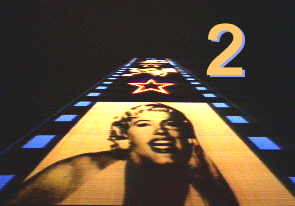
 Among
the other things that the MPPC did to hold on to control (and profits) was to forbid
the use of actor's names in film credits.
Among
the other things that the MPPC did to hold on to control (and profits) was to forbid
the use of actor's names in film credits.
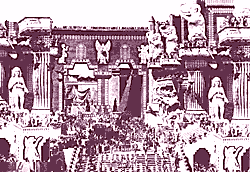 message of love, tolerance, and the futility of war. It cost almost 20 times
as much to make as Birth of a Nation, and in terms of technique was more
impressive (note one of the elaborate scenes on the left). Even so, it was a box-office
flop.
message of love, tolerance, and the futility of war. It cost almost 20 times
as much to make as Birth of a Nation, and in terms of technique was more
impressive (note one of the elaborate scenes on the left). Even so, it was a box-office
flop.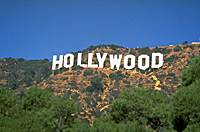 area.
area. As
we've noted, the Motion Picture Patents Company (MPPC) didn't want to list the names
of actors in their films because they feared that the actors would become well known
and would want more money.
As
we've noted, the Motion Picture Patents Company (MPPC) didn't want to list the names
of actors in their films because they feared that the actors would become well known
and would want more money.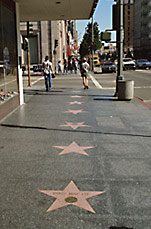 (the
comic genius whose plight we'll discuss later).
(the
comic genius whose plight we'll discuss later).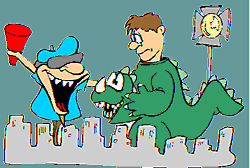 silent film era--slapstick comedians who packed theaters.
silent film era--slapstick comedians who packed theaters. 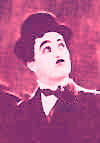 His
character was best displayed in the film, The Tramp,
in which he played a vagabond in baggy pants and a tight coat who comes to rescue
a pretty girl. Disaster and disappointment befall him at every turn. (In Module
9 we'll see that another film that is considered by some critics to be his best
work.)
His
character was best displayed in the film, The Tramp,
in which he played a vagabond in baggy pants and a tight coat who comes to rescue
a pretty girl. Disaster and disappointment befall him at every turn. (In Module
9 we'll see that another film that is considered by some critics to be his best
work.)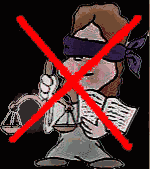 They saw McCarthy's questions as invasive and improper. All 10 were given prison
sentences. In addition, some were fined up to $10,000.
They saw McCarthy's questions as invasive and improper. All 10 were given prison
sentences. In addition, some were fined up to $10,000.